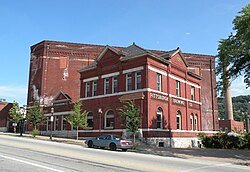Iron City Brewing Company
 Iron City Brewing Company
Iron City Brewing CompanyThe Iron City Brewing Company (also known as the Pittsburgh Brewing Company) is a beer company that until August 2009 had been located in the Lawrenceville neighborhood of Pittsburgh, Pennsylvania, United States. On June 11, 2009, it was reported that the brewery was "moving" to Latrobe, Pennsylvania. That move was recently completed and Iron City is now produced in the Latrobe Brewery that was once used to produce Rolling Rock.
In 1861, a young German immigrant, Edward Frauenheim, started the Iron City Brewery, one of the first American breweries to produce a lager, in the bustling river port known at the time as the "Smoky City." This founder of Frauenheim, Miller & Company started brewing Iron City Beer, now the flagship of the Iron City Brewing Company (PBC), in a city thriving on heavy industry and commerce.
By 1866, the brewery had begun to grow. The business outgrew its original facilities on 17th Street and moved into a four-story brick building that the company built at Liberty Avenue and 34th Street, then worth an estimated $250,000. Just three years later, Iron City Brewery erected an additional three-story building at the site.
The two buildings, carrying an average stock of about 10,000 barrels, used state-of-the-art brewing equipment. At the time, 25 of the operation's 30 skilled workmen were employed full-time, and Iron City Brewery continued to expand its markets to become the largest brewery in Pittsburgh.
After the 1866 expansion, Leopold Vilsack, a Pittsburgh native who learned the brewer’s trade at Pittsburgh’s old Bennett Brewery, joined Frauenheim, Miller & Company. The young man later became a partner, investing his small wealth in the firm when Miller retired and another partner died. Iron City Brewery then became Frauenheim and Vilsack Company.
Frauenheim and Vilsack’s fame spread throughout the brewing industry across the country, as the company had built one of the most complete and extensive breweries in the United States. With a brewing capacity of about 50,000 barrels a year, the Iron City Brewery was an impressive operation, able to compete favorably in sales with any brewery west of the Atlantic Coast area. Historians and newspapers were amazed that a brewery could be so big. The total value of Iron City, from stock to raw materials, was about $150,000 – an unheard of sum for a brewery.
...
Wikipedia